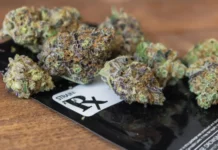It’s no secret that cannabis has medicinal effects on humans. But can it help our pets as well?
Dr. Casara Andre, founder of Cultivate Veterinary Wellbeing in Wheat Ridge, wondered the same thing after watching her boyfriend’s father battle cancer. He eventually turned to cannabis.
“I saw it make days bearable for him,” Andre says. Cannabis eased activities like eating and interacting with family and, as a veterinarian, Andre wanted to know how animals would respond to similar treatments. Her first animal patient was her own 15-year-old cat that had arthritis and inflammatory bowel disease. Over time, she was able to develop a treatment plan for her pet using CBD and THC products to help with each of her cat’s issues.
Following the success with her cat, Andre treated her other pets and the pets of friends with cannabis products. She has been professionally educating clients at Cultivate for a year now. “I don’t think I would have gotten into treating pets with cannabis in a wider professional sense if it hadn’t been such a life changer for her,” Andre says of her cat.
An array of pet products with CBDs exist, from treats to soft chews, though tinctures may be more effective. But there are issues: Side effects can occur, pets are highly sensitive to THC, and dosages must be appropriate to avoid a trip to the emergency vet. Since dogs in particular have extreme THC sensitivity, many CBD products for pets are derived from hemp.
While seeking help from a vet is an important step, vets have to be careful about how they talk to clients about cannabis use, and a pet owner must initiate the conversation. Vets are not authorized to prescribe cannabis, which can only legally be recommended to humans, not animals. Still, many vets are interested in the treatments. Colorado’s own Dr. Rob Silver even authored Medical Marijuana & Your Pet: The Definitive Guide.
In the past year, Cultivate has already seen a number of success stories. Andre says the clinic has helped transition cats from traditional medicines to cannabis-only treatment plans. Older dogs often receive cannabis for pain, especially toward the end of life, which can bring peace of mind to owner and pet. The staff at Cultivate has even helped amputee animals reduce inflammation caused by increased strain on their remaining limbs.
“Nowhere in medicine is there a recipe [that works for] every animal, but definitely not in cannabis; it has to be very individualized,” Andre says. This is due to the fact that when you’re working with cannabis you’re affecting the endocannabinoid system. Composed of neurotransmitters and cannabinoid receptor proteins throughout the central nervous system in mammals, the endocannabinoid system is involved in regulating many of the body’s systems, including, but not limited to, fertility, appetite, pain sensation, and mood. What holistic veterinarians like Andre are doing is trying to identify in what ways the endocannabinoid system is deficient or overexcited in some way and bring it back to a balance, using similar principles as acupuncture and massage.
This imbalance could be caused by a number of diseases and conditions, but typically illnesses that cause pain or inflammation fall into this category. “Any disease that brings the body out of whack, cannabis is really good at bringing it back to homeostasis,” Andre says.
The first goal is always harm reduction; making sure pets don’t overdose or become intoxicated, and that the cannabis treatment works well with other medication the pet may be taking. It’s important that throughout the process the pet owner and veterinarian work as a team, Andre says, because some of the negative side effects will only show themselves through blood work. Other signs an animal has a wrong dosage are unsteady movements, sensitivity to bright light, or sensitivity to loud sounds. However, most bad reactions come from inattentive owners who aren’t keeping an eye on their pet and ensuring dosages are appropriate.
“It’s easy to do right, but we like to make sure owners are really prepped on how to do it right,” Andre says.
Lastly, it’s important to start slow and ease your pet into treatments, or changes in a treatment, and make sure the home is somewhere they can feel safe. Signs that treatment is working vary from disease to disease, but typically animals suffering from chronic pain will have an easier time eating and be more active. Other illnesses may show signs of improvement as well but may take the trained eye of a veterinarian to notice initially.














